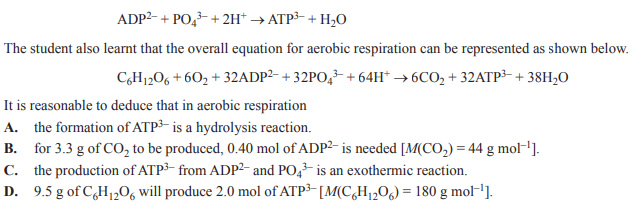1) Bioethanol, C2H5OH, is produced by the fermentation of glucose, C6H12O6, according to the following equation. C6H12O6(aq) → 2C2H5OH(aq) + 2CO2(g) The mass of C2H5OH
obtained when 5.68 g of carbon dioxide, CO2, is produced is
A. 0.168 g
B. 0.337 g
C. 2.97 g
D. 5.94 g
Solution

2) Four fuels undergo complete combustion in excess oxygen, O2, and the energy released is used to heat 1000 g of water. Assuming there is no energy lost to the environment, which one of these fuels will increase the temperature of the water from 25.0 °C to 85.0 °C?
A. 0.889 g of hydrogen, H2
B. 3.95 g of propane, C3H8
C. 0.282 mol of methane, CH4
D. 0.301 mol of methanol, CH3OH
Solution
3) Organic acids, including vitamin C (ascorbic acid), are present in lemon juice. Since organic acids and vitamin C are weak acids, they will undergo acid-base reactions. Only vitamin C, not the organic acids, will undergo a redox reaction with iodine, I2. Which one of the following methods would be most appropriate to determine the concentrations of the organic acids and the vitamin C in a sample of lemon juice?
A. an acid-base titration with sodium hydroxide and phenolphthalein indicator
B. an acid-base titration with ammonia and phenol red indicator, and a redox titration with iodine and permanganate ion indicator
C. an acid-base titration with sodium hydroxide and methyl orange indicator, and a redox titration with iodine and a starch indicator
D. an acid-base titration with potassium hydroxide and phenolphthalein indicator, and a redox titration with iodine and a starch indicator
Solution

4) In the human body, not all energy available from the metabolism of food is dissipated as heat energy. A student carried out further research on this and found that some of the energy is used in the production of adenine triphosphate, ATP3–, from adenine diphosphate, ADP2–, and inorganic phosphate, PO4 3–, according to the following equation.  A. the formation of ATP3– is a hydrolysis reaction.
A. the formation of ATP3– is a hydrolysis reaction.
B. for 3.3 g of CO2to be produced, 0.40 mol of ADP2– is needed [M(CO2) = 44 g /mol].
C. the production of ATP3– from ADP2– and PO4 3– is an exothermic reaction.
D. 9.5 g of C6H12O6will produce 2.0 mol of ATP3– [M(C6H12O6) = 180 g /mol].
Solution
